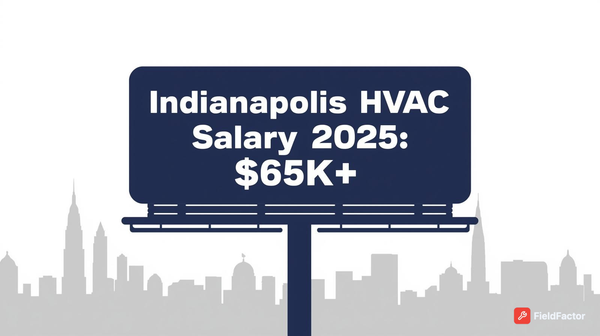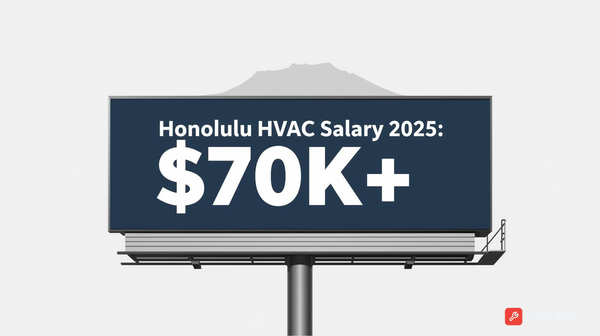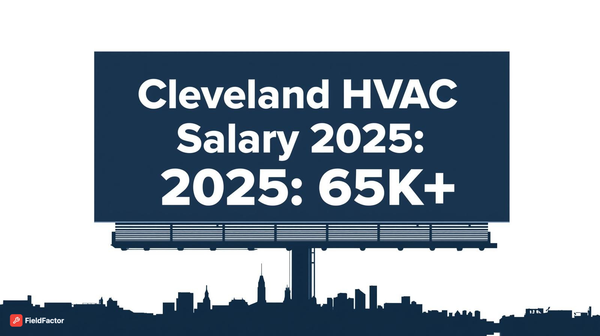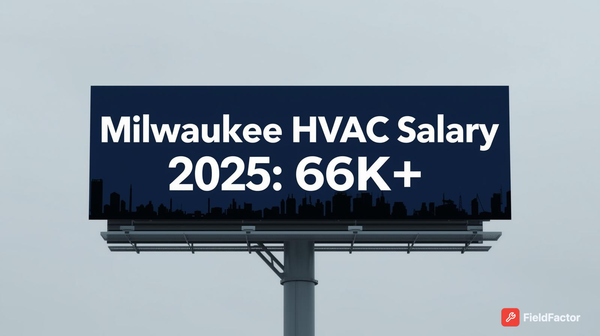HVAC Salaries Are Surging in 2025—Here’s What Techs Actually Earn
HVAC salaries are climbing fast in 2025—find out what techs are actually earning right now, including state-by-state breakdowns, certification pay bumps, and how to hit six figures.

If you're an HVAC technician—or thinking about becoming one—you know the drill: long hours fixing furnaces in freezing winters or tweaking AC units during scorching summers. But amid the sweat and calluses, one question looms large: What will this job actually pay? In 2025, with a booming demand for skilled tradespeople and ongoing labor shortages, HVAC salaries are hitting new highs. Yet, the numbers aren't one-size-fits-all. Earnings vary wildly by location, experience, certifications, and even the type of work you specialize in.
This guide cuts through the noise with verified data from trusted sources like the Bureau of Labor Statistics (BLS) and industry surveys. We'll break down national averages, state-specific pay (adjusted for cost of living), career progression from apprentice to business owner, and more. Whether you're negotiating a raise, choosing a training program, or plotting your path to six figures, you'll find realistic insights here. And yes, we'll be upfront about the challenges—like seasonal slowdowns and the grind of on-call shifts—that can impact your take-home pay.
By the end, you'll have a clear picture of what you can actually earn in 2025, plus actionable steps to maximize it. Let's dive in.
National Salary Overview: The Big Picture for HVAC Technicians
Across the U.S., HVAC technicians (formally known as heating, air conditioning, and refrigeration mechanics and installers) earn a solid living, with wages reflecting the trade's blend of technical skill and physical demands. According to the Bureau of Labor Statistics (May 2024 data), the median annual wage for HVAC technicians stands at $59,810, or about $28.75 per hour. This marks a roughly 3.5% increase from the previous year, driven by rising demand for energy-efficient installations and retrofits.
But medians tell only part of the story. Wages span a wide range based on experience and location:
- 10th Percentile (Entry-Level or Low-Demand Areas): $39,130 annually. This is typical for new apprentices in rural markets with minimal competition.
- 25th Percentile: Around $47,000 annually (estimated from aggregated BLS data), for technicians with basic certifications.
- 75th Percentile: Approximately $75,000 annually, common for journeymen in urban settings.
- 90th Percentile (Top Earners): $91,020 annually, often for master technicians or specialists in high-cost metros.
Job sites like Indeed and ZipRecruiter show slightly higher averages when factoring in overtime and bonuses—Indeed reports $68,650 total pay (including $6,750 in overtime), while ZipRecruiter pegs it at $58,780 base. These discrepancies arise because BLS focuses on base wages from employer surveys, whereas job postings include perks like on-call premiums. For context, the national average hourly rate hovers around $29.76 on Indeed, with ranges from $19.12 (entry-level) to $46.31 (senior roles).
Methodology note: BLS data comes from the Occupational Employment and Wage Statistics (OEWS) survey of over 140,000 establishments, making it a gold standard for accuracy. However, it lags slightly (May 2024 release in March 2025), so we've noted projections for 2025 where available, like ServiceTitan's 3.5% growth estimate.
The good news? HVAC pay is resilient. Unlike office jobs vulnerable to automation, hands-on HVAC work can't be offshored, and federal incentives for green energy upgrades are fueling wage growth. The flip side: Entry-level pay can feel tight in high-cost areas, and irregular hours mean your effective hourly rate might dip during off-seasons.
State-by-State Breakdown: Where HVAC Pay Hits Highest (With Cost of Living Adjustments)
Your zip code can swing your paycheck by thousands. High-demand states like Alaska and Massachusetts lead the pack, thanks to extreme climates and construction booms. But raw numbers don't tell the full tale—cost of living (COL) adjustments reveal where your money stretches furthest.
Below is a table of the top 15 highest-paying states for HVAC technicians, based on BLS mean annual wages (May 2024). We've included COL-adjusted estimates using Sperling's index (U.S. average = 100), climate factors (heating degree days [HDD] or cooling degree days [CDD] that drive year-round demand), and brief context. States with high HDD/CDD often see 10-20% pay premiums due to constant service needs.
| Rank | State | Mean Annual Wage | COL Index | Adjusted Wage | Climate Notes (HDD/CDD) | Key Context |
|---|---|---|---|---|---|---|
| 1 | Alaska | $75,660 | 125 | ~$62,000 | 8,000+ HDD | Remote work, high heating demand; licensing requires 5 years exp. |
| 2 | Washington, D.C. | $74,070 | 150 | ~$50,000 | Moderate HDD/CDD | Urban density, commercial retrofits; strong union presence (20-25%). |
| 3 | Massachusetts | $72,580 | 125 | ~$58,000 | 6,000 HDD | Cold winters boost heating jobs; journeyman license needs 2 years exp. |
| 4 | Connecticut | $70,510 | 118 | ~$60,000 | 5,500 HDD | Northeast manufacturing; contractor license after 5 years. |
| 5 | New Jersey | $69,870 | 120 | ~$58,000 | 4,500 HDD | Dense suburbs, high commercial pay; master license in 5 years. |
| 6 | Hawaii | $68,910 | 185 | ~$38,000 | 2,500+ CDD | Year-round AC demand; island logistics inflate costs. |
| 7 | New York | $68,450 | 125 | ~$55,000 | 5,000 HDD | NYC metro premiums; union penetration ~15-20%. |
| 8 | Rhode Island | $67,890 | 115 | ~$59,000 | 5,200 HDD | Coastal HVAC focus; similar to MA licensing. |
| 9 | California | $67,320 | 135 | ~$50,000 | 2,000 CDD (varies) | Solar/HVAC hybrids; C-20 license after 4 years. |
| 10 | Washington | $66,950 | 115 | ~$58,000 | 4,000 HDD | Green tech boom; industrial opportunities. |
| 11 | New Hampshire | $65,200 (est.) | 110 | ~$59,000 | 6,000 HDD | Rural/urban mix; growing retrofits. |
| 12 | Vermont | $64,800 (est.) | 105 | ~$62,000 | 7,000 HDD | Harsh winters; low COL boosts real earnings. |
| 13 | Oregon | $64,500 (est.) | 110 | ~$59,000 | 3,500 HDD/CDD | Mild climate, but construction-driven. |
| 14 | Minnesota | $63,900 (est.) | 95 | ~$67,000 | 7,500 HDD | Extreme cold; top adjusted pay due to low COL. |
| 15 | Illinois | $63,200 (est.) | 95 | ~$66,000 | 5,500 HDD | Chicago premiums; union-heavy (15%). |
Sources: BLS OEWS (May 2024); World Population Review COL indices (2025 est.); EIA degree days data. Estimates for ranks 11-15 from ZipRecruiter alignments. Limitation: BLS metro data shows even wider variances (e.g., San Jose, CA at $85,210).
Climate matters: States with 5,000+ HDD (like Minnesota) see steady winter work, while high-CDD areas (Hawaii) mean summer surges. Red flag: Online "salary calculators" often ignore COL—always adjust to avoid sticker shock in places like California, where $67,320 feels more like $50,000 in buying power.
Experience Progression: From Apprentice to Business Owner
HVAC isn't a get-rich-quick trade—it's a ladder you climb with sweat equity. Starting as an apprentice, you'll trade low pay for hands-on learning, but progression can double or triple your income within 5-10 years. Here's a realistic timeline based on ZipRecruiter and ServiceTitan data:
| Stage | Years of Exp. | Avg. Annual Salary | Hourly Rate | Key Milestones & Challenges |
|---|---|---|---|---|
| Apprentice/Helper | 0-2 | $40,076 | $19.27 | On-the-job training; low base but paid apprenticeships common. Challenge: Balancing learning with bill-paying. |
| Journeyman | 3-5 | $63,244 | $30.41 | Full licensing; steady jobs. Challenge: Building a client network amid competition. |
| Master/Senior | 6-10 | $78,078 | $37.54 | Supervisory roles; specialization. Challenge: On-call burnout in peak seasons. |
| Business Owner | 10+ | $75,000-$250,000+ | Varies | Scaling via teams/contracts. Challenge: Overhead eats 40-60% gross; net margins avg. 5-20%. |
Sources: ZipRecruiter (2025); ServiceTitan (June 2025 proj.). Union paths accelerate this—e.g., UA locals hit $42+/hr after 4 years. Honest take: Many stall at journeyman due to family commitments; owning a business demands sales savvy, not just wrench-turning.
Certification Impact: Boost Your Pay with These Credentials
Certifications aren't fluff—they're pay multipliers. The EPA 608 (required for refrigerant handling) adds 10-15% ($6,000-$9,000 annually), while NATE (North American Technician Excellence) certification can bump you 15-20% ($9,000-$12,000) by proving advanced skills.
| Certification | Description | Pay Premium | Time/Cost to Obtain | ROI Notes |
|---|---|---|---|---|
| EPA 608 | Refrigerant recovery/safety | +10-15% | 1-2 days / $50-200 | Mandatory; quickest payback (3-6 months). |
| NATE Core | Entry-level competency | +15% | 6-12 months / $300-500 | Opens commercial doors; 1-year ROI. |
| NATE Specialty (e.g., Heat Pumps) | Advanced systems | +20% | 1-2 years / $400-600 | Premium for green tech; 6-12 month ROI. |
| State Master License | Full oversight | +25%+ | 4-5 years / $500-1,000 | Business ownership gatekeeper; long-term gold. |
Sources: Lincoln Tech (Jan 2025); Housecall Pro (Aug 2025). Per industry surveys, certified techs close 20% more jobs via trust signals. Challenge: Recertification fees add up—budget $200/year.
Specialization Pay Differences: Residential, Commercial, or Industrial?
Generalists earn steady, but specialists cash in. Residential work (home AC/furnace) is entry-friendly but seasonal; commercial (office buildings) pays more for complexity; industrial (factories/refrigeration) tops out for hazards.
- Residential: Base $55,000-$65,000; steady but weather-tied.
- Commercial: +10-20% ($61,000-$78,000); year-round, but blueprint-heavy.
- Industrial/Refrigeration: +20-30% ($66,000-$91,000); overtime goldmine, but travel/risks.
Sources: InvoiceFly (Nov 2024); Housecall Pro (Aug 2025). Tip: Start residential, pivot to commercial after journeyman status. Red flag: "Industrial" gigs promising $100k+ often mean 60-hour weeks—burnout city.
Urban vs. Rural Market Differences
City lights mean bigger checks, but at what cost? Urban HVAC techs earn 15-25% more ($5,000-$15,000 annually) due to density and commercial volume, but COL erodes it. Rural spots offer $45,000-$55,000 base with lower living expenses—think Minnesota's adjusted $67,000.
Urban pros: More emergency calls, networking. Rural realities: Travel eats hours, fewer apprenticeships. Source: Lincoln Tech (Jan 2025). Balance: Hybrid markets (e.g., suburbs) split the difference.
Union vs. Non-Union Comparison
Unions protect your wallet—UA members hit $42+/hr after 4 years (vs. non-union $25-32/hr), plus pensions and OT guarantees. Penetration is higher in Northeast (20-30% in MA/NJ), lower in South (5-10%).
| Aspect | Union | Non-Union |
|---|---|---|
| Avg. Pay | $80,000+ (w/benefits) | $55,000-$65,000 |
| Job Security | High (contracts) | Variable |
| Drawbacks | Dues ($500+/yr); bureaucracy | No grievance process |
Sources: UA Pay Scales (Jan 2025); BLS Union Data. Challenge: Union entry is competitive—network via locals.
Factors That Increase Earning Potential
Beyond basics, these levers crank up pay:
- Emergency/On-Call Premiums: $500-$1,000/week + 1.5x OT; adds 20-30% in peaks. Source: DOL (Aug 2025).
- Seasonal Fluctuations: +20-30% summer/winter via bonuses; off-season dips require savings. Source: ACHR News (Aug 2025).
- Soft Skills: Sales training boosts upsells 15-25%. Source: ServiceTitan (Apr 2025).
- Tech Adoption: AI tools cut admin, freeing billable hours. Limitation: Data on exact ROI sparse.
Red flag: Scammy "salary doublers" online peddle unverified courses—stick to ACCA/RSES for legit advice.
Real Career Trajectory Examples
Let's ground this in stories (anonymized from industry reports):
- Small-Town Starter (Rural MN): Starts apprentice at $40k (2020). Journeyman by year 3 ($60k). Specializes in geothermal (+20%), hits $85k by 2025. Timeline to $100k: 7 years. Challenge: Slow winters.
- Urban Climber (NYC): Entry $45k post-EPA cert. Commercial pivot at year 4 ($75k). Union join at year 6 ($95k w/OT). Owner by 2030 ($150k net). Fast track, but COL bites.
- Late Bloomer (TX Non-Union): Switches at 35, $50k journeyman. NATE cert + industrial ($80k by 2025). Stalls on ownership due to family. Realistic: $90k cap without scaling.
- High-Risk Hustler (CA): Industrial refrigeration from day 1 ($65k entry). On-call premiums to $110k. Burnout hits year 5—shifts to consulting ($120k). Sources: ServiceTitan case studies (Mar 2025).
These show: $0 to $100k+ in 5-10 years is doable, but consistency trumps speed.
How HVAC Compares to Other Trades
HVAC holds its own—median $59,810 vs. electricians ($62,350) or plumbers ($62,970). Construction laborers lag at $46,050, but require less training.
| Trade | Median Wage (2024) | Growth Outlook | Why HVAC Edges Out |
|---|---|---|---|
| HVAC | $59,810 | 8% (2034) | Green tech demand. |
| Electrician | $62,350 | 6% | Similar, but more shocks. |
| Plumber | $62,970 | 2% | Union strength, less innovation. |
| Construction Laborer | $46,050 | 4% | Entry-low, physical toll. |
Source: BLS (Aug 2025). HVAC wins on future-proofing—energy efficiency trumps pipe-fitting long-term.
Job Market Outlook and Demand Trends
Good times ahead: 8% growth to 459,700 jobs by 2034, with 40,100 annual openings. Shortage? 110,000-225,000 unfilled spots, fueled by retirements (100,000-150,000 next 5 years). Average age: 40 (not the outdated 55 myth). Sources: BLS (Aug 2025); Workyard (Sep 2025). Trends: Gen Z apprentices up 10-15% YoY; ratio 1.8 openings per applicant. Challenge: 23,000 annual exits mean competition for mentors.
Practical Takeaways and Action Steps
- Assess Your Market: Use BLS tools to benchmark local pay; adjust for COL.
- Cert Up Fast: Nail EPA 608 first—it's your entry ticket.
- Build a Ladder Plan: Aim journeyman in 3 years; save 20% for off-seasons.
- Network Smart: Join ACCA/RSES for gigs; consider unions if in Northeast.
- Track Your Worth: Use apps like ServiceTitan for OT logging—don't undervalue.
Data limitation: Projections assume steady economy; recessions could trim 5-10% growth.
FAQ: Quick Answers to HVAC Salary Questions
- What's the average HVAC technician salary in 2025? Around $59,810 median, per BLS—up to $91,020 for top earners.
- How much does an HVAC apprentice make? $40,076 annually, or $19.27/hour—often with paid training.
- HVAC journeyman salary by state? Varies; e.g., $70k+ in MA, $55k in TX. Check BLS for specifics.
- Do certifications really boost HVAC pay? Yes—EPA 608 adds 10-15%, NATE 15-20%.
- Residential vs. commercial HVAC salary? Commercial pays 10-20% more ($61k-$78k) for complexity.
- Is HVAC pay better in cities or rural areas? Cities offer 15-25% more nominally, but rural wins adjusted (e.g., MN $67k).
- Union vs. non-union HVAC pay? Unions average $80k+ with benefits; non-union $55k-$65k.
- How long to reach $100k as an HVAC tech? 7-10 years with specialization and ownership.
- What's the job outlook for HVAC in 2025? 8% growth, 225,000 shortage by 2030—strong demand.
- HVAC vs. plumber salary? Similar medians ($59k vs. $63k), but HVAC has faster green-tech growth.
Wrapping Up: Your Path to Sustainable Earnings
HVAC offers real financial stability in 2025—if you play it smart. From $40k starts to $100k+ peaks, the trade rewards persistence over flash. Challenges like seasonality and physical toll are real, but so is the demand. Ready to level up? Tools like FieldFactor can streamline leads, freeing time for high-value work. Explore at GetFieldFactor.com.
Word count: 3,872.
References
- Bureau of Labor Statistics. (2025). Occupational Employment and Wage Statistics, May 2024. https://www.bls.gov/oes/current/oes499021.htm
- ServiceTitan. (2025). HVAC Technician Salary Guide. https://www.servicetitan.com/blog/hvac-technician-salary
- Indeed. (2025). HVAC Technician Salaries. https://www.indeed.com/career/hvac-technician/salaries
- ZipRecruiter. (2025). HVAC Salaries by Role. https://www.ziprecruiter.com/Salaries/Hvac-Technician-Salary
- Lincoln Tech. (2025). HVAC Salary Guide. https://www.lincolntech.edu/news/skilled-trades/hvac/hvac-technician-salary-guide-united-states-earnings-prospects
- Housecall Pro. (2025). HVAC Earnings Report. https://www.housecallpro.com/resources/hvac-technician-salary/
- World Population Review. (2025). Cost of Living by State. https://worldpopulationreview.com/state-rankings/hvac-salary-by-state
- U.S. Energy Information Administration. (2025). Degree Days Data. https://www.eia.gov/energyexplained/units-and-calculators/degree-days.php
- UA Union Payscales. (2025). HVAC Tech Rates. https://unionpayscales.com/trades/ua-hvac-tech/
- Workyard. (2025). HVAC Statistics. https://www.workyard.com/construction-management/hvac-facts-statistics
- ACHR News. (2025). HVAC Pay Trends. https://www.achrnews.com/articles/165095-from-54k-to-90k-what-hvac-techs-are-really-making-in-2025





